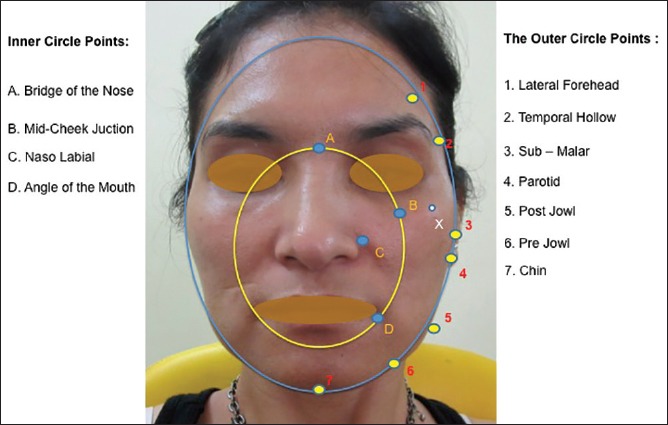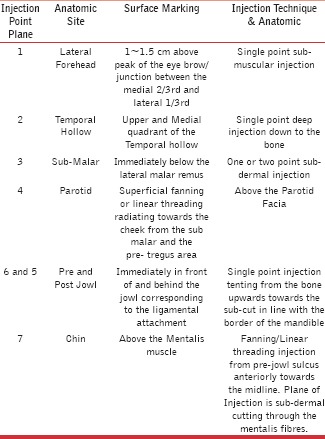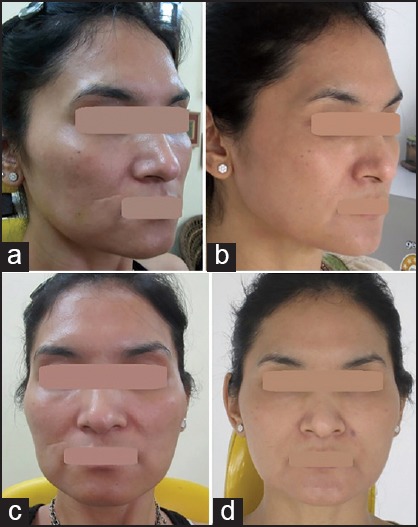Abstract
Introduction:
An oval face, pronounced cheek bones, a defined jaw line and a smooth Ogee curve are global aesthetic beauty goals. Though criteria are similar the Indian face poses some unique challenges because of the innate differences in skeletal shape, size, and soft tissue disposition. Width of the malar prominences and mandibular angles along with height are smaller compared to the other Asian and Caucasian populations along with a much heavier soft tissue disposition. This creates unique deficits and places unique demands on aesthetic intervention.
Objectives:
The evolution of practice patterns has lead to a variety of newer approaches; however, it is still common to target the nasolabial and mid-face volumizing as basic intervention for facial beautifying and rejuvenation. As aging progresses, Indian faces tend to get fuller and the tissue then descends downwards similar to other ethnic groups albeit more aggressive due to higher volumes of facial fat pad and smaller bone framework. Any excess correction in the inner circle zones will further add to the bulk along with cumulative remnants of previously administered fillers.
Methods:
In a younger face when the goal is beautification the attempt is to address the specific structural deficit on the outer bony framework along with the chin. This enhances the appearance immediately as well as holds up the tissue descent as they age. When the goal is youthful transition of an aging face, then again the bony changes further enhance the deficit in framework and the loss of fat pads along the periphery that is lateral forehead, temples and lateral cheek. Fat pad correction will give the most natural and best results as against working on the anterior mid cheek, nasolabials and angle of the mouth in a soft tissue heavy center zone of the face. Botulinum toxin and hyaluronic acid (HA) fillers remain the most popular facial injectables used for facial rejuvenation and structural enhancement.
Results:
Naturally enhanced faces, and gracefully addressed aging changes are important. Fillers administered on the outer zones of the face rather than the inner zone gives better aesthetic results.
KEYWORDS: Filler, Indian face, injectables, inner circle, nasolabial, outer circle, peripheral zone, piriformis, rejuvenation, volumiser
INTRODUCTION
There is an increasing global consensus across different ethnic groups and regions on the defining attributes of facial beauty that an oval face, pronouned cheek bones, a defined jaw line and a smooth Ogee curve seem to be the ideal aesthetic goal. While the perception is the same in India, the Indian face poses some unique challenges. From Lambros's theory of facial aging, it was suggested that bony changes of the mid-face may be summarised as a clockwise rotation of the mid-face relative to the cranial base.[1] Facial aging is a dynamic process involving the aging of soft-tissue and bony structures having an impact on overall facial aesthetics. Changes in the underlying skeletal support structure in conjunction with atrophy and expansion of the soft-tissue envelope create an imbalance in the ideal relationship between the two seen in youth.[2,3,4,5] As humans age, upper skeletal frame work of the face moves clockwise and the angle of the piriformis is reduced due to bone resorption, malar prominence is reduced, infro-lateral orbital margin is elongated, and the bone support of the lateral mid-face is compromised leading to the clouding of tissues at the anterior mid face.[4,5,6] Indian faces have innate differences in skeletal shape, size, soft tissue disposition in the face, width of the malar prominences and mandibular width and height, which are much smaller compared to the other populations.

Indian Male Face vs North American Caucasian Male Face[7]

Indian Female Face vs North American Caucasian Female Face[7]
The findings shown in the above tables prove that the width of the bone framework in Indian Men is comparably smaller than their North American Causcasian counterparts and that the width of bone framework in Indian Female is also comparably smaller than their Causasian counterparts.[7] Indian faces tend to get fuller and tissues descend downwards and medially making it complicated for aesthetic correction.[8,9,10] Also in signifcant Indian population, the lower 1/3rd of the face is much shorter in comparision to the upper 1/3rd and the mid 1/3rd of the face. Although the nasolabial fold correction is widely accepted as the most basic and effective approach in aesthetic correction, with an India face, this should be performed with significant care. To reinforce Lambros's theory of bone depletion along the piriformis, reducing the angle there only adds to the crowding of tissues.[9,10,11] Nasolabial and anterior mid-face should be filled with caution and minimalistic approach with volumiser placed deep and maximum correction done in the external zones of the face to compensate for bone, fat loss and skin excess and overall structural decent. Any excess correction will end up adding to the bulk which then settles in over a period, cumulatively leaving the center even more bulky. Following the approach defined in this paper gives a harmonious, smooth and aesthetically satisfying result within an Indian's sensibility of beauty requiring less correction in the long term for a given patient. Fillers/Volumisers are the focal point of this paper. Although for targeting overall rejuvenation and enhancement, treatments like laser/intense pulsed light (IPL), radio frequency, micro needles and peels are common treatments used to improve skin tone, texture and clarity, these are not described as these are beyond the scope of this manuscript.
MATERIALS AND METHODS
Patient and treatement
This is a retrospective study of 40 cases of total facial rejuvenation with injectables treated over the last 4 years at Ra Skin N Aesthetics, Mumbai, India and Reva Health and Skin, Hyderabad, India. The study tracked and analyzed the data of 40 (7 men: 33 women) patients with ages ranging from 30 to 60 years old. These patients were segregated into three categories based on aging, early - below 40 years, mid: 40-50 years and late: Above 50 years.
Once the depressors like supero-lateral orbicularis occuli, corrugater complex, platysma, deppresor angulioris were relaxed with standard doses of neuro-toxin, work with volumisers was planned. In areas like sub-malar and parotid and mandibular angle, in addition to bolus, the fanning technique with needle or cannula was used depending on the extent of intervention required.
Product preference
In majority of cases Juviderm Ultra Plus/Ultra Plus XC and Voluma was used. Most of the injection points tend to work with small deposits with needles. Total volumes of volumisers were kept to 2-3 mL and additional 0.5 mL was used for deep temporal hollow when required. Materials used are Juverderm Voluma in all the points except periorbital area Point B [Figure 1] where Juviderm ultra plus/Juviderm ultra plus XC.
Figure 1.

Surface marking. Inner circle targets for aesthetic corrections: A: Bridge of the nose, B: Mid-cheek junction, C: Nasolabial and D: Angle of the mouth. Outer circle targets for aesthetic corrections: 1. Lateral forehead, 2. Temporal Hollow, 3. Sub-malar, 4. Parotid, 5. Post-jowl, 6. Pre-jowl and 7. Chin
Surface marking and injection techniques
After consultation with the patients and taking aesthetic goals into consideration, a combined analysis or assessment of the facial aesthetics was planned [Figure 1]. Among the patients (40 numbers) who underwent aesthetic correction, 50% of the patients were concerned about a line or a particular deficit that had to be rectified while others had more general concerns of looking tired or skin sagging pointing out to the lower face/jowl. Following this, the patient was counseled on the details of treatment, and the areas that need to be worked from the forehead or temples to actually be able to elicit rejuvenation or lifting effect on the lower face. Patient consent, documentation and preparation were then completed.
Referring to Figure 1, the points, surface marking and injection techniques are:

Point X and angle of the jaw are optional points to complete the facial rejuvenation when there is a requirement to enhance malar prominence and the angle of the jaw.
Early [Figure 1] a single-point technique with standard guide lines in each area to avoid the vital structures along the points 1, X and 7 in a round face to glamourise and to stretch out the tissues, then if need point B for a single deep injection,[12] point C superficially in a linear threading fashion and point D with single bolus for supporting the collar of the mouth.
Mid [Figure 2] in a moderate case, in addition to the above points as in early, 4 and 5 are covered, mostly by single point technique but fanning at times in the pre jowl area depending upon the bone and adipose density loss in the marionette area.
Figure 2.

Example of a female subject in the mid-age group (a) Before treatment and (b) After treatment; (c) Before treatment and (d) After treatment
Late [Figure 3] in this age scenario, all the points [Figure 1] will be addressed; however, the correction will be initiated by injecting from the temple onwards, upto point 1 and sequentially all the others points. The parotid and the sub-malar area needed to be treated with superficial fanning, so the filler was placed above the parotid facia which is important to avoid the neurovascular structure. Wider area is covered to give more tissue lift and stretch without volumising excessively.
Figure 3.

Example of a female subject in the late age group (a) Before treatment and (b) After treatment
Lower face was addressed with deeper placement of product with high G’ to build up the structural support. Collapse of Marionette rather than just lines are observed due to bone loss over an already shorter body of the mandible and also more often due to disproportionately smaller chin in both Indian men and women. In these scenarios, chin enhancement should be considered as one of the points while working towards a youthful face. Then the points B and C are considered with deep point injections to compensate the Suborbicularis Oculi Fat (SOOF) pads and piriformis bone resorption, respectively, and which is then finished with superficial linear threading or fern techniques.
RESULTS
The outer circle methodology yielded significant improvement in resistance to age-related facial decent towards the centre. This methodology also minimised the need for mid-face volumising inturn further slowing down the inevitable downward decent of potentially bulked up soft tisssue. The result observed across the patients is of a naturally fresh and youthful look. This method also minimises the need for mid-face volumising and repeat touchups and filling sessions as is normaly done. Any subsequent injection sessions will not lead to cummulative product load adding up further onto ongoing soft tissue and skeletal changes thus maintaining the natural look that is much desired. This new method yields not only a more aesthetic outcome but has also demonstrated longer resistance to facial aging factors.
CONCLUSIONS
Most Indian subjects get worried when fillers or volumisers are offered as choices. Over the years, repeated sessions of fillers has led to faces looking “over done”. It is best to use the zones described here for aesthetic enhancement and counteracting/compensating the aging changes rather than working on the mid zone, as doing so only adds on to the adverse changes. Aesthetic seekers are usually self-critical and tend to repeatedly seek interventions. Additionally we have observed in practice that facial volumisers, specially hyaluronic acids, do not resolve completely and tend to accumulate over repeated sessions. As the face changes with age, the bony framework changes according to Lambros's theory,[1] and further bone resorption is maximum at the piriformis according to the study by Shaw et al.[4] which leads to soft tissue crowding towards the mid-face anteriorly.[5] Any filler that may add volume and cumulatively stay on will only make it worse.[12] The last indication one should touch is the nasolabial as it only adds to the volume heavy face. Indian face is prepared to age gracefully or beautifully by fillers administered on the outer zones than the inner ones. With patients followed up to 4 years, aesthetic correction on the points [Figure 1] and technique described in paper has resulted in the best aesthetic outcome in comparison to those patients treated with more popular mid-face volumising and ‘chasing the nasolabial’. Working on the outer zones of the face has a very positive effect on the diverse facial shapes seen in India: The fuller, round south Indian by giving them the skeletal frame work; the bigger yet soft tissue heavy north Indian by giving them the angles for a more sleeker illusion and on the more boney north-east Indian by making the outer zones softer. Indians in general tend to prefer small faces so it is important to be cautious before adding bulk to the outer zone especially around the lateral malar areas. This unique method is also ideal for younger patients looking to delay the onset of facial aging factors and is a great new and lasting alternative for older patients who would otherwise require frequent touchups with the conventional mid-face volumising method. No specific impact of other modalities of rejuvenation and routine skin care were taken into consideration in this study.
ACKNOWLEDGEMENTS AND/OR DISCLOSURE OF INTEREST
The author has no financial interest in any manufactured products mentioned in this article.
Footnotes
Source of Support: Nil.
Conflicts of Interest: The authors certify that they have obtained all appropriate patient consent forms. In the form the patient(s) has/have given his/her/their consent for his/her/their images and other clinical information to be reported in the journal. The patients understand that their names and initials will not be published and due efforts will be made to conceal their identity, but anonymity cannot be guaranteed.
REFERENCES
- 1.Pessa JE. An algorithm of facial aging: Verification of Lambros's theory by three-dimensional stereo lithography, with reference to the pathogenesis of mid facial aging, scleral show, and the lateral suborbital trough deformity. Plast Reconstr Surg. 2000;106:479–88. doi: 10.1097/00006534-200008000-00040. [DOI] [PubMed] [Google Scholar]
- 2.Swift A, Remington K. BeautiPHIcation™: A global approach to facial beauty. (v).Clin Plastic Surg. 2011;38:347–77. doi: 10.1016/j.cps.2011.03.012. [DOI] [PubMed] [Google Scholar]
- 3.Pessa JE, Chen Y. Curve analysis of the aging orbital aperture. Plast Reconstr Surg. 2002;109:751–60. doi: 10.1097/00006534-200202000-00051. [DOI] [PubMed] [Google Scholar]
- 4.Shaw RB, Jr, Kahn DM. Aging of the midface bony elements: A three-dimensional computed tomographic study. Plast Reconstr Surg. 2007;119:675–3. doi: 10.1097/01.prs.0000246596.79795.a8. [DOI] [PubMed] [Google Scholar]
- 5.Coleman SR, Grover R. The anatomy of the aging face: Volume loss and changes in 3-dimensional topography. Aesthet Surg J. 2006;26:S4–9. doi: 10.1016/j.asj.2005.09.012. [DOI] [PubMed] [Google Scholar]
- 6.Stuzin JM. Restoring facial shape in face lifting: The role of skeletal support in facial analysis and midface soft-tissue repositioning. Plast Reconstr Surg. 2006;119:362–78. doi: 10.1097/01.prs.0000251092.82860.25. [DOI] [PubMed] [Google Scholar]
- 7.Jagadish Chandra H, Ravi MS, Sharma SM, Rajendra Prasad B. Standards of facial esthetics: An anthropometric study. J Maxillofac Oral Surg. 2012;11:384–9. doi: 10.1007/s12663-012-0355-9. [DOI] [PMC free article] [PubMed] [Google Scholar]
- 8.Farkas LG, Katic MJ, Forrest CR, Alt KW, Bagic I, Baltadjiev G, et al. International anthropometric study of facial morphology in various ethnic groups/races. J Craniofac Surg. 2005;16:615–46. doi: 10.1097/01.scs.0000171847.58031.9e. [DOI] [PubMed] [Google Scholar]
- 9.Ngeow WC, Aljunid ST. Craniofacial anthropometric norms of Malaysian Indians. Indian J Dent Res. 2009;20:313–9. doi: 10.4103/0970-9290.57372. [DOI] [PubMed] [Google Scholar]
- 10.Prasanna LC, Bhosale S, D’souza AS, Mamatha H, Thomas RH, Sachin KS. Facial indices of North and South Indian adults: Reliability in stature estimation and sexual dimorphism. J Clin Diagn Res. 2013;7:1540–2. doi: 10.7860/JCDR/2013/5497.3204. [DOI] [PMC free article] [PubMed] [Google Scholar]
- 11.Edler RS. Background considerations to facial aesthetics. J Orthod. 2001;28:159–68. doi: 10.1093/ortho/28.2.159. [DOI] [PubMed] [Google Scholar]
- 12.Shetty R. Under eye infraorbital injection technique: The best value in facial rejuvenation. J Cosmet Dermatol. 2014;13:79–84. doi: 10.1111/jocd.12075. [DOI] [PubMed] [Google Scholar]


